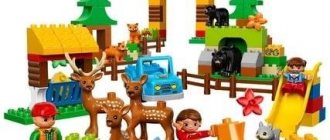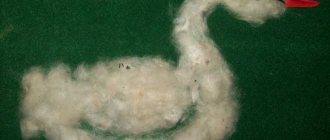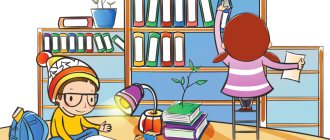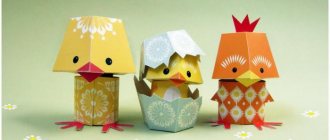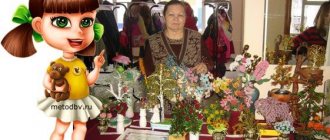SEPTEMBER
1. "SPIDER"
Etc. sod.: teach children to make crafts from various natural materials, to see in them similarities with individual parts. Learn to give the spider expressiveness, create a composition using several spiders and additional objects. Foster a caring attitude towards natural materials.
Materials: thistle flowers, cardboard, awl, wire, acacia seeds, scissors, PVA glue.
Literature: V. Pudova “Toys from natural gifts” p.30
2. “ROOM OF LAUGHTER”
Etc. sod: strengthen children’s ability to fold paper, create a cheerful mood, develop imagination, and the ability to depict different facial expressions using paper.
Materials: thin cardboard or thick album sheet, colored paper, scissors, glue.
Literature: “Working with paper. Crafts and games" page 10
3. "PAPER COUNTRY"
Etc. sod.: teach children to make a variety of toys from the same blank and establish their similarity to familiar objects; learn how to do crafts based on diagrams; develop constructive thinking and intelligence; expand personal and gaming experience; enrich your vocabulary.
Materials: a large sheet of whatman paper, diagrams, squares of colored paper of different sizes and colors for making houses, squares of green paper for making fir trees, scissors, glue, colored paper for decorating houses.
Literature: “Working with paper. Crafts and games" pp. 16-17
4. “BUZZERS”
Etc. sod.: teach children to make musical instruments from various waste materials, design crafts according to their wishes, develop imagination and intelligence, teach them to listen carefully to the work plan.
Materials: yogurt cups, round stick, match, fishing line, rosin, awl, knife. (The teacher does the work with the awl and knife in advance)
Literature: O. Zhakova “Let’s make some noise” pp. 10-11
Card file of work assignments for children of the preparatory group
Ekaterina Smirnova
Card file of work assignments for children of the preparatory group
Task No. 1
"Watering indoor plants"
.
Goal: to expand children’s about the needs of plants for light and moisture, to teach how to recognize moisture-loving and drought-resistant, light-loving and shade-tolerant plants by their leaves. Develop accuracy when working with water and plants, confidence in your actions, work skills . Foster a caring attitude towards the natural environment and a desire to take care of it.
Task No. 2
"Washing houseplants"
.
Purpose: to give children an idea of watering methods (in a tray, under leaves)
and rules
(do not flood, water evenly)
;
cultivate a desire to care for plants. Involve children in all possible help , clarify children’s about indoor plants.
Task No. 3
“Spraying indoor plants with water from a spray bottle”
.
Goal: teach a new work skill ; reinforce children’s that leaves also need moisture; cultivate a caring attitude towards plants. Teach children to independently determine the need for watering (by the color and condition of the soil, by the appearance of the plant, recall the watering technique.
Task No. 4
“Green landing on indoor plants”
(remove diseased leaves, fertilize)
.
Goal: to teach children to determine by the condition of indoor plants what actions are necessary to care for them (watering, cleaning, loosening, fertilizing, correctly perform the relevant labor operations , invite the children to tell about the purpose of each of them.
Task No. 5
"Taking care of plants"
.
Goal: to clarify previously acquired knowledge about ways to keep plants clean, to teach children how to choose a method for removing dust from a plant, focusing on the features of its appearance and structure.
Task No. 6
“Loosening the soil of indoor plants”
.
Goal: teach children to care for indoor plants; give children knowledge about why it is necessary to loosen the soil of plants; consolidate loosening techniques and rules for using the necessary items for this. Develop labor skills , accuracy. Foster an ecological culture and respect for the environment.
Task No. 7
"Feeding plants"
.
Goal: to tell children about the need to feed plants, based on children’s that the source of nutrition for plants is the soil, and that gradually, by giving nutrients to plants, the soil is depleted. Show how to fertilize plants.
Task No. 8
"Washing pallets"
.
Goal: to teach children to do work independently and responsibly, distribute responsibilities, and coordinate actions.
Task No. 9
"Transplanting indoor plants"
.
Goal: to expand children’s understanding of the labor involved in caring for plants of various types: to learn how to replant indoor plants. Introduce children to the sequence and technique of work, the rules of personal hygiene, and offer to provide all possible assistance to the teacher.
Task No. 10
"Planting Onions"
.
Goal: to teach children to set a goal, prepare a workplace , tools and clean up after themselves. To consolidate children's knowledge about the structure of the onion , about the conditions necessary for onion growth. Develop labor skills and habits , accuracy when working with land, water and plants. Foster an environmental culture, a desire to achieve results, and participate in a common cause.
Task No. 11
"Planting pea seeds"
.
Goal: invite children to tell how a plant grows from a seed, clarify and supplement the children’s . To update and specify ideas about the conditions necessary for the growth of peas.
Task No. 12
“Sowing seeds of flowers and vegetables”
.
Goal: to give children knowledge that every plant has seeds. Teach the sequence of actions required when sowing seeds: make a hole in the ground (to sow seeds, each time marking the distance between them and the grooves with a stick); teach to observe cultural and hygienic skills when working. To consolidate children's knowledge about at what time, which seeds are sown in boxes in a group for preparing seedlings , and which seeds are sown in open ground. Develop labor skills and abilities . Foster an ecological culture, a caring attitude towards the natural environment, and a desire to take care of it.
Task No. 13
“Planting seedlings, caring for them”
.
Goal: to form children’s about the main stages of plant growth and development (seed, seedling, stem with leaves)
;
about the basic methods of growing plants and caring for them (planting in loose soil, watering, loosening the soil, weeding, feeding). Be careful when planting seedlings, as the plants are very fragile. Develop labor skills and habits , accuracy when working with land, water and plants.
Foster an ecological culture, a caring attitude towards the natural environment, and a desire to take care of it. Task No. 14
"Dining duty"
.
Goal: to teach children to independently and conscientiously perform the duties of a duty officer. Wash your hands thoroughly, put on the duty officer's clothes, and set the table correctly. Clear dishes after meals. Develop labor skills and abilities , the ability to see disorder in the table setting. Foster a desire to work for the benefit of others .
Task No. 15
“Duty in the educational activity zone”
Goal: independently and conscientiously fulfill the duties of the duty officer: lay out on the tables materials and aids prepared by the teacher for the lesson; wash, if necessary, put them back in place after class.
Task No. 16
“We will prepare equipment and materials for educational activities”
.Goal: to develop a sense of responsibility for
the assigned task , to teach children to carefully lay out materials and equipment for educational activities.
Task No. 17
Remove plasticine and modeling boards.
Goal: to develop teamwork skills
Task No. 18
“Learning to make our beds”
.
Goal: to bring to the awareness of children how to properly make the bed; cultivate independence, accuracy, and the desire to help adults. Foster a responsible attitude towards self-care work and independence.
Task No. 19
“Assisting the junior teacher in laying out bedding on the beds.”
Goal: to teach how to sort bed linen according to their belongings, to cultivate a desire to help the junior teacher and respect for other people’s work . Cultivate a desire to work , a sense of responsibility for the assigned work .
Task No. 20
"Changing dirty towels"
.
Goal: maintain a steady interest in work , the desire to diligently complete the assignment . Learn to hang a towel in an individual compartment. Foster a desire to work and help adults .
Task No. 21
"Order in the dressing room closet"
(together with the junior teacher)
Goal: to teach children to maintain order in their personal wardrobes: empty the closet of clothes and shoes, wipe the shelves with a damp cloth, and neatly put the clothes back in place. Develop diligence , the ability to see disorder, and accuracy when working with water. Cultivate a desire to work together in a team .
Task No. 21
"Washing chairs"
.
Goal: to teach children to help the junior teacher, to keep the chairs in the group room : wipe them with a damp cloth; put in place. Develop labor skills and abilities , the ability to comply with cultural and hygienic requirements when working. Foster a desire to help adults and respect for their work .
Task No. 22
"Washing building materials"
.
Goal: to teach how to wash, dry and lay building materials, to teach children to constantly and promptly maintain order in the play corner, to wash building materials with a soapy solution prepared by the teacher, to rinse and dry them; observe the rules of personal hygiene.
Task No. 23 Wet cleaning of modules for construction.
Goal: to develop teamwork skills .
Task No. 24
“We wipe the dust off the shelves for games and toys”
.
Goal: continue to teach children to wipe dust from shelves with a damp cloth. Develop labor skills and abilities . To cultivate aesthetic taste and the desire to work for the benefit of others .
Task No. 25
"Cleaning up order in the group after the game "
.
Goal: to form in children a conscious desire for order, the habit of putting away toys after playing. Improve the ability to draw up a work plan and select the necessary materials for upcoming activities.
Task No. 26
"Order in toys"
Goal: to teach children to put on work aprons before starting work; to keep toys in order: wash, dry, wipe and put in place. Develop diligence , the ability to see disorder; be careful when working with water. Cultivate respect for your own work and the work of others .
Task No. 27
"Washing Dolls"
.
Goal: to teach children to help the teacher in washing dolls: rinse soaked dolls, clean them with brushes. Develop diligence , the ability to see disorder, and accuracy when working with water. Foster a desire to help adults and respect for their work .
Task No. 28
Maintain the appearance of the dolls: select clothes, comb, tie a bow.
Goal: to foster a sense of satisfaction from the work done.
Task No. 29
"Washing doll's clothes"
.
Goal: to teach children to help the teacher in washing doll clothes and bedding. Teach children to put on work aprons before starting work; prepare the necessary supplies for washing and drying, as well as a workplace; know how to use soap. Develop labor skills and abilities , the ability to comply with cultural and hygienic requirements when working. Foster a desire to work for the benefit of others .
Task No. 30
“Washing napkins used for visual arts”
.
Goal: to teach children the skills of soaping , rinsing and wringing out napkins, to continue to form a work (tidiness in the process of work)
.
Task No. 31
"Keeping your manual closet tidy"
.Goal: to teach
children to organize manuals on their own, maintain order in closets, and wipe dust.
Task No. 32 “We wipe the window sills with a damp rag in the group room and bedroom .” Goal: to teach children to follow the following rules when working with water: roll up their sleeves, wet the cloth and wring it dry, and rinse it in water when it gets dirty. Task No. 33
"Cleaning up building material"
.Goal: to teach how to wash, dry and lay building materials, to teach
children to constantly and promptly maintain order in the play corner, to wash building materials with a soapy solution prepared by the teacher, to rinse it, and to dry it;
observe the rules of personal hygiene. Task No. 34 “Cleaning the play corner”
.Goal: to teach
children to put on work aprons before starting work;
keep toys in order, wash them, dry them, wipe them and put them in place. Task No. 35 “Place the chairs in a certain order”
.Goal: continue to develop
labor skills ; carry out the assignment carefully , quickly, diligently.
Task No. 36 “Repairing boxes for waste material”
.Goal: to consolidate technical skills in working with scissors and glue, to cultivate frugality, and the ability to work collectively.
Task No. 37
"Work in the book corner"
.
(book restoration)
.
Goal: to teach children to choose books that need repair, carefully glue them (use glue and scissors correctly, use napkins)
.
Cultivate a caring attitude towards books, a desire to work , and maintain order.
Task No. 38
“Work in the book corner: we help repair books from the library of the junior group .”
Goal: invite children to help repair children's books. Cultivate a caring attitude toward books and mutual assistance. Develop and teach how to use book repair skills.
Task No. 39 “We have order in our closet”
.Goal: to teach
children to be careful when folding things in the outerwear cabinet.
Task No. 40
"General cleaning in a group room "
.
Goal: invite children to carefully examine the group room and determine what needs to be done to put things in order; Together with the teacher, outline a work plan. Learn to organize joint work . Create responsibility for carrying out assignments .
OCTOBER
1. "BEADS"
Etc. sod.: teach to work carefully with a needle, learn the rules of using a needle, teach children to make crafts from natural materials; develop. Continue teaching preschoolers to clean their workspace. Handle natural materials carefully.
Material: acacia seeds, strong threads, needles, if desired, melon and watermelon seeds.
Literature: V. Pudova “Toys from natural gifts” p.38
2. "TABLECLOTH"
Etc. sod.: teach children to make a variety of toys from the same blank and establish their similarity to familiar objects; learn how to do crafts based on diagrams; continue to learn how to fold paper carefully, iron the folds; develop constructive thinking and intelligence; expand personal and gaming experience; enrich your vocabulary, listen carefully to your teacher and comrades.
Materials: craft diagram, sample, squares of colored paper of different colors, colored paper for decoration, scissors, glue.
Literature: “Working with paper. Crafts and games" page 20
3. “TURNTABLES”
Etc. sod.: teach children to make a variety of toys from the same blank and establish their similarity to familiar objects; learn how to do crafts based on diagrams; develop constructive thinking and intelligence; expand personal and gaming experience; enrich your vocabulary.
Materials: squares of colored paper, pencil for making sticks, cloves, hammer.
Literature: “Working with paper. Crafts and games” page 22.
4. “GIRAFFE. ZEBRA"
Etc. sod.: learn to make crafts from matchboxes, supplement the crafts with details, giving expressiveness and resemblance to real animals. Continue learning to analyze the drawing and sample. Encourage children to make crafts for later use in the game. Develop creativity, imagination, thinking.
Materials: matchboxes, colored paper, samples, diagrams, glue, scissors, simple pencils.
Literature: Tarlovskaya “Teaching preschool children design and manual labor” table 13
Manual labor club in the preparatory group “Chest of Ideas”
Municipal budgetary preschool educational institution "Kindergarten of a general developmental type with priority implementation of activities for the cognitive and speech development of children No. 9 "Yakutyanochka"
Manual labor club in the preparatory group “Chest of Ideas”
Educator: MBDOU No. 9 “Yakutyanochka” Klimovskaya Natalya Valerievna.
Explanatory note
Manual labor is a universal educational tool that can balance one-sided intellectual activity.
Physiologists have found that our fingers are organically connected to the brain, the speech center. Therefore, hand training stimulates the body’s self-regulation and increases the functional activity of other organs. The relationship between development and intelligence has long been known. Even the simplest manual works require constant attention and make a child think. Skillful use of hands further enhances the development of the brain. Making crafts is not only about certain movements. This allows you to work on the development of practical intelligence: it teaches children to analyze a task and plan its progress.
One of the main tasks of teaching and raising children in applied arts classes is to enrich the student’s worldview, i.e. development of the child’s creative culture (development of a creative non-standard approach to the implementation of a task, nurturing hard work, interest in practical activities, the joy of creating and discovering something new).
A child learns the world through manipulation, that is, actions with various objects that allow him to recognize and study their properties, while learning his creative abilities and changing what he touches. One of the child’s assistants in this most important task for his development is working with paper. Being the most accessible for children, applied creativity has the necessary emotionality, attractiveness, and effectiveness.
The purpose of the circle: the development of manual skills in children through strengthening fine motor skills of the fingers and organizing joint visual creativity of children and adults.
Objectives: - To introduce children to the basic concepts and basic forms of various techniques; — Teach children various techniques for transforming paper, natural and waste materials. — To develop the ability to take into account the properties of materials when making crafts from them. — Enrich the child’s vocabulary with special terms; — Create compositions with products made using various techniques of working with paper; -Develop attention, memory, logical and spatial imagination; — Develop fine motor skills of the hands and eye; — Develop artistic taste, creativity and imagination of children; — Form a work culture and improve work skills; -Improve communication skills. — To develop neatness, the ability to use materials carefully and economically, to keep the workplace in order.
The circle is attended by 11 children. Time for this activity is allocated outside of class: in the afternoon. The duration of productive activities with children varied depending on the situation and the desires of the children. A flexible form of organizing child labor in leisure activities made it possible to take into account the individual characteristics of children, desires, health status, level of mastery of skills, being at a certain stage of the implementation of the plan and other possible factors. Each child worked at his own level of difficulty and begins work from where he left off.
The classes were held in the form of a game; to play out a certain plot, poetic forms, fairy tales, moving and finger games, characters (toys and dolls from various theaters, images of a particular character who is played out) are used.
The implementation period for the circle is 9 months. The number of classes per month is three. There are 27 lessons in total. Also, the works were sent to an international Internet competition, where my students were awarded diplomas of participation. Thus, at the International Children’s Creative Drawing Competition “Space Travel” in the international educational portal “MAAM”, a participant’s diploma was given to Harbin Dayaan, Natasha Nikolaeva.
At the International Children's Creative Competition of Autumn Crafts "Autumn Fantasies" and New Year's Crafts in the International Educational Portal "MAAM" Diploma of Participant - Borisov Gleb, Rozhin Kolya, Makarova Milena, Kalitina Naori, Ivanova Zhenya, Efremova Polina, Sleptsova Polina, Petukhova Dayaana, Equipment: Paper of different formats, colors, quality, colored cardboard; Watercolor paints, glue, scissors, plasticine, buttons, cotton wool, felt-tip pens, pencils, brushes, natural and waste materials.
NOVEMBER
1. “KOKOSHNIKI”
Etc. sod.: teach children to use different natural materials to decorate the kokoshnik, to create a composition. Cultivate a caring attitude towards natural materials and accuracy. Develop imagination, imagination, sense of rhythm.
Materials: kokoshniks made of cardboard and pasted velvet paper, seeds of various plants, dried flowers, leaves, scissors, PVA glue, brushes, sample.
Literature: V. Pudova “Toys from natural gifts” pp. 41-43
2. "CATAMARANS"
Etc. sod.: teach children to make a variety of toys from the same blank and establish their similarity to familiar objects; learn how to do crafts based on diagrams; analyze the diagram; develop constructive thinking and intelligence; expand personal and gaming experience; enrich your vocabulary.
Materials: squares of colored paper, colored paper for decoration, scissors, glue, brushes, diagrams, sample.
Literature: “Working with paper. Crafts and games" page 22
3. “STEAMBOAT WITH TWO PIPES”
Etc. sod.: teach children to make a variety of toys from the same blank and establish their similarity to familiar objects; learn how to do crafts based on diagrams; develop constructive thinking and intelligence; expand personal and gaming experience; enrich your vocabulary.
Materials: squares of colored paper, colored paper for decoration, album sheet or cardboard (1/2 sheet), scissors, glue, diagrams, sample.
Literature: “Working with paper. Crafts and games" page 24
4. “PICTURE FRAME”
Etc. sod.: teach children to fold paper in different directions, making a picture frame. Develop the ability to analyze a drawing. Do the work carefully.
Material: rectangular sheets of white paper (or wallpaper), simple pencil, ruler, drawing.
Literature: Tarlovskaya “Teaching preschoolers design and manual labor” p. 173.
DECEMBER
1. "CARPET"
Etc. sod.: teach children to make appliqué from natural material on a plasticine basis, develop creativity, imagination, sense of rhythm, learn to compose a composition.
Material: cardboard of various shapes and sizes, plasticine, seeds of various plants.
Literature: V. Pudova “Toys from natural gifts” p.66
2. “COCKER WITH A CHICKEN” (with CSR)
Etc. sod.: teach children to make a variety of toys from the same blank; learn how to do crafts based on diagrams; analyze the diagram; teach children to work in pairs of constant composition, develop patience in children when explaining material, teach them to tell the sequence of doing crafts (one child one way, the other another way), develop speech, develop constructive thinking and intelligence; expand personal and gaming experience; enrich your vocabulary.
Materials: squares of colored paper, colored paper for additional details, scissors, diagrams, glue, samples.
Previous Work: teaching children different ways of making toys.
Literature: “Working with paper. Crafts and games" pp. 30-31
3. “JUMPING”
Etc. sod.: teach children to make a variety of toys from the same blank; learn how to do crafts based on diagrams; analyze the diagram; teach children to work in pairs of constant composition, develop patience in children when explaining material, teach them to tell the sequence of doing crafts (one child one way, the other another way), develop speech, develop constructive thinking and intelligence; expand personal and gaming experience; enrich your vocabulary.
Materials: squares of colored paper, colored paper for additional details, scissors, diagrams, glue, samples.
Previous Work: teaching children different ways of making toys.
Literature: “Working with paper. Crafts and games" pp. 38-39
4. “SNOWFLAKES”
Etc. sod.: teach children to make appliqué from natural material on a plasticine basis, develop creativity, imagination, sense of rhythm, learn to compose a composition.
Material: cardboard of various shapes and sizes, plasticine, seeds of various plants.
Literature: V. Pudova “Toys from natural gifts” p.68

